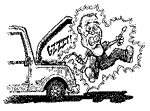| |
 Jim Grant's Tech Tips
Jim Grant's Tech Tips
95
GMC Jimmy, EGR Carbon Problems
Q: I
recently bought a used '95 GMC Jimmy at a dealer with 78,000 miles with
a 30 day warranty. The very next day after the warranty expired the fuel
pump also expired. After replacing the fuel pump a code for the EGR pintle
out of position occurred. Upon inspection of the EGR it appeared that
it had been recently replaced. I personally pulled the unit and found
pieces of carbon stuck in it keeping the pintle from closing all the way.
I removed the carbon and reinstalled the EGR. The problem caused a serious
idling effect. The very next day the same thing happened. I cleared the
EGR again and the Jimmy ran fine. My question is where does the carbon
come from and will this continue to happen? Is this a problem unique to
Central Multi-Port Fuel Injection systems or is there some special maintenance
that I need to perform to prevent it from happening again. Any info would
be appreciated...........Don
A:
The
valve that you are referring to is GM's Linear Exhaust Gas Recirculation
(LEGR) valve which is common to GM vehicles equipped with a 4.3 liter
engine. The LEGR valve has been prone to carbon problems that cause the
valve to stick open. When carbon deposits get caught in the valve it can
turn the Check Engine Light on and the driver of the vehicle may experience
problems such as engine surge, stalling, rough idle, and/or hard starting.
Where does the carbon come from? The exhaust system. The LEGR valve introduces
metered amounts of exhaust gases back to the engine. As the hot exhaust
gases travel through the cooler passage, leading to the LEGR valve, the
gases will cool and form deposits. Over time the deposits can build up
and break off. If the deposits get caught in the valve, it will stick
open and cause driveability problems. ALLDATA Information Systems shows
GM Technical Service Bulletin # 96067 addressing problems caused by deposits
of foreign material affecting the LEGR valve. The fix was a revised program
for the computer that would increase the movement of the valve, reducing
the chance of debris being caught in the valve.
|
|



